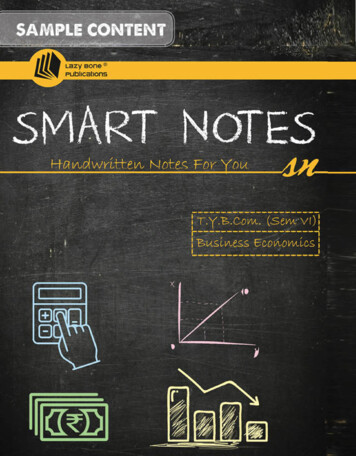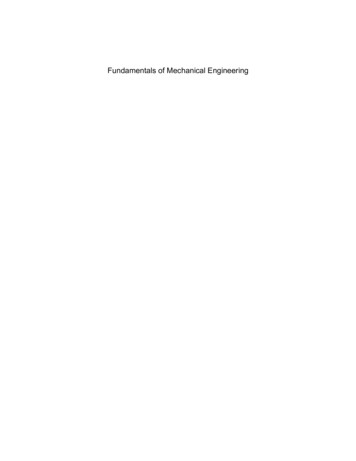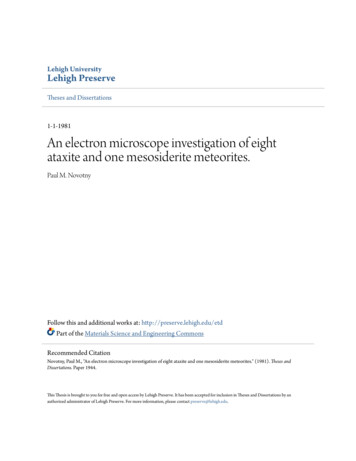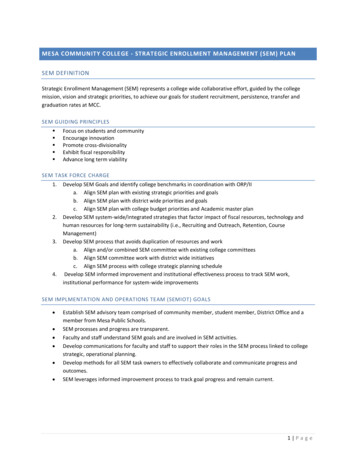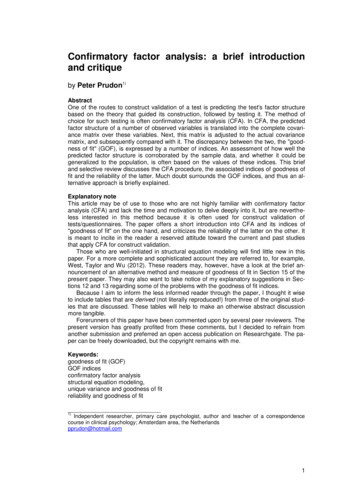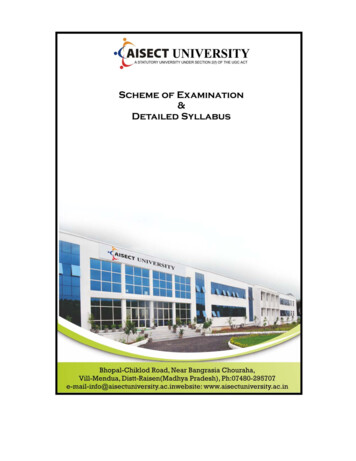
Transcription
DIPLOMA INMECHANICAL ENGINEERINGSem-I to VI
COURSE STRUCTURE OF DIPLOMA IN MECHANICAL ENGINEERINGSEMESTER – I, SET A B Course [ME, CE]SubjectSubject NameCodeTotalMarksDE‐101Applied MechanicsDE‐102Environmental Engg. & SafetyDE‐103Introduction to ComputersDE‐104Engg. DrawingDE‐106Professional ActivityPractical GroupDE‐101Applied MechanicsDE‐102Environmental Engg. & SafetyDE‐103Introduction to ComputersDE‐105Workshop PracticeSEMESTER – IISubjectCode10010010010050505050Subject NameTotalMarksDE‐201Communication ematicsDE‐205Professional ActivityPractical GroupDE‐202Engg. PhysicsDE‐203ChemistrySEMESTER – IIISubjectCode1001001001005050Subject NameTotalMarksDME 301Material TechnologyDME 302Manufacturing ProcessesDME 303Basic Electrical & ElectronicsMechanical Drafting & Auto CADDME 304DME 305Strength of MaterialDME 306Professional ActivitiesPractical GroupDME 301Material TechnologyDME 302Manufacturing ProcessesDME 303Basic Electrical & ElectronicsDME 305Strength of MaterialSEMESTER – IVSubjectCode10010010010010050505050Subject NameTotalMarksFluid Mechanics & Hydraulic MachinesDME 401DME 402Thermal EngineeringDME 403Theory of MachinesDME 404Industrial ManagementDME 405EntrepreneurshipDME 406Professional ActivitiesPractical GroupFluid Mechanics & Hydraulic MachinesDME 401DME 402Thermal EngineeringDME 403Theory of Machines//Diploma in Mech. Engg.100100100100100505050December 16, 2013TheoryMaxMinMarks MarksAssignmentMaxMinMarks Marks70707070223012223012223012223012GRADE TO BE AWARDEDTerm EndLab Work3012208301220830122083012208TheoryMaxMinMarks MarksAssignmentMaxMinMarks Marks70707070223012223012223012223012GRADE TO BE AWARDEDTerm EndLab Work30122083012208TheoryMaxMinMarks MarksAssignmentMaxMinMarks Marks7070707070223012223012223012223012223012GRADE TO BE AWARDEDTerm EndLab Work3012208301220830122083012208TheoryMaxMinMarks Marks7070707070AssignmentMaxMinMarks Marks223012223012223012223012223012GRADE TO BE AWARDEDTerm EndLab 434202020
SEMESTER – VSubjectCodeSubject NameTotalMarksDME 501Process Planning, Estimating &costingDME 502Machine Tool TechnologyDME 503Engineering Measurements andMaintenance PracticesDME 504Modern Practices inManufacturing and ManagementDME 505Industrial EngineeringDME 506Professional ActivitiesPractical GroupDME 502Machine Tool TechnologyDME 503Engineering Measurements andMaintenance PracticesDME 504Modern Practices inManufacturing and ManagementDME 505Industrial EngineeringSEMESTER – VISubjectCodeDME 601DME 602Subject Name//Diploma in Mech. Engg.AssignmentMaxMinMarks 303012123434100702230123410070345050223012GRADE TO BE AWARDEDTerm EndLab Design of Machine ElementsOption (any one) Automobile Engineering CAD/CAMDME 603Option (any one) Refrigeration and AirConditioning Power Plant EngineeringDME 604ProjectDME 605Professional ActivityPractical GroupDME 602Option (any one) Automobile Engineering CAD/CAMDME 603Option (any one) Refrigeration and AirConditioning Power Plant EngineeringDME 604ProjectTheoryMaxMinMarks MarksTheoryMaxMinMarks MarksAssignmentMaxMinMarks 434100702230123410010030123012Lab Work20834345070227022Term End30125030122082050301220820December 16, 201320
DE 101SEMESTER IAPPLIED MECHANICSRATIONALE:In the wider sense “Applied Mechanics” may be defined as a science which deals withthe problems related to objects in motion or in equilibrium.Depending on the discipline of the technicians the depth of knowledge and extent ofareas of mechanics will vary.Only those topics which form common requirement of the different courses and thoseto, a depth required by all have been included in this subject. Further study of thissubject in respect of topic/ depth is left out and could be integrated with their use insubjects like theory of structure, strength of materials, theory of mechanics and basicmachine design.COURSE CONTENT:1.COMPOSITION AND RESOLUTION OF FORCES1.1Definition, Effect, characteristics of force.1.2System of Forces.1.3Principle of Transmissibility of Forces.1.4Concept of Resultant Force.1.5Law of‐1.62.3. Parallelogram of Forces Triangle of Forces Polygon of ForcesDetermination of Resultant of two or more concurrent forces(analytically and graphically).PARALLEL FORCES AND COUPLES2.1Classification of Parallel Forces.2.2Methods of finding resultant Force of parallel forces‐ analytically &graphically.2.3Position of resultant force of parallel forces.2.4Definition, Classification and characteristics of a force Couple, moment ofcouple.MOMENTS AND THEIR APPLICATIONS3.1Definition, Types and law of moment.3.2Varignon’s Principle of moment and its applications.3.3Lever and its Applications.3.4Types of supports and determination of support reactions of a simplysupported beam subjected to point load and uniformly distributed load(UDL).//Diploma in Mech. Engg.December 16, 2013
4.5.6.78EQUILIBRIUM OF FORCES4.1Equilibrium of a system of concurrent forces.4.2Conditions and types of Equilibrium.4.3Lami’s Theorem and its applications.CENTRE OF GRAVITY5.1Difference between Centroid and Center of Gravity (CG).5.2Centroid of standard plane figures and CG of simple solid bodies.5.3Method of finding out Centroid of composite plane laminas and cutsections.5.4Method of finding out CG of Composite solid bodies.FRICTION6.1Concept and types of friction.6.2Limiting Friction, coefficient of friction, angle of friction, angle of repose.6.3Laws of friction ( Static and Kinetic).6.4.Analysis of equilibrium of Bodies resting on Horizontal and inclinedPlane.6.5Utility / Nuisance value of friction.SIMPLE LIFTING MECHINES7.1Concept of lifting Machines.7.2Definition of Mechanical Advantage, Velocity Ratio and Efficiency ofMachines and their relation.7.3Reversibility of Machines and condition for self locking machine.7.4Law of Machines, Maximum mechanical advantage and maximumefficiency of machine.7.5Friction in machine ( In terms of Load and effort).7.6Calculation of M. A, V.R. and efficiency of following machines Simple wheel and axle Differential wheel and axle Single purchase crab Double purchase crab Simple screw jack Different System of simple pulley blocksMOTION OF A PARTICLE8.1Definition of speed, velocity, acceleration, uniform velocity, uniformacceleration and variable acceleration.8.2Motion under constant acceleration/ retardation ( equations of motion).8.3Motion under force of gravity.8.4Concept of relative velocity.//Diploma in Mech. Engg.December 16, 2013
8.5Definition of projectile, velocity of projection , angle of projection, time oflight, maximum height, horizontal range and their determination.8.6Definition of angular velocity, angular acceleration and angulardisplacement.8.7Relation between linear and angular velocity of a particle moving in acircular path.8.8Motion of rotation under constant angular acceleration.9LAWS OF MOTION9.1Newton’s Laws of motion and their applications.10WORK, POWER AND ENERGY10.1 Definition unit and graphical representation of work.10.2Definition and unit of power and types of engine power and efficiency ofan engine.10.3Definition and concept of Impulse.10.4Definition, unit and types of energies.10.5Total energy of a body falling under gravity.LIST OF EXPERIMENTS:1. Verification of laws of parallelogram of forces.2. Verification of laws of polygon of forces3. Verification of laws of moments4. Determination of forces in the members of Jib Crane5. Determination of Centroid of plane lemina by graphical method6. Determination of coefficient of friction for surfaces of different materials onhorizontal plane7. Determination of coefficient of friction for surfaces of different materials on aninclined plane8. Determination of mechanical advantage, velocity ration and efficiency of thefollowing lifting machines Simple wheel and axle Differential wheel axle Single purchase crab Double purchase crab Simple pulley block Simple screw jack9. Measurement of B.H.P. of an engine using roap break dynamometerREFERENCE BOOKS:1. A text book of Applied Mechanics ‐ R.S. Khurmi, S.C. Chand & Co. , New Delhi2. Applied Mechanics ‐ I.B. Prasad, Khanna Publishers, New Delhi//Diploma in Mech. Engg.December 16, 2013
3. Applied Mechanics ( Hindi) ‐ R.S. Jog, Anand Publishers, Gwalior4. Applied Mechanics ( Hindi) ‐ A.R. Page, Deepak Prakashan, Gwalior//Diploma in Mech. Engg.December 16, 2013
DE 102ENVIORNMENTAL ENGINEERING & SAFETYRATIONALE:Engineers and scientists from a number of related disciplines have been involved overyears in the development of an academic basis for understanding and management ofthe environment. The purpose of keeping the Environment Engineering & Safety is tointroduce a unique approach to the overall concept of environmental engineering anapproach that emphasizes the relationship between the principles observed in naturalpurification processes and those employed in engineered processes.COURCE CONTENTS:1.2.3.INTRODUCTION TO ENVIRONMENT1.1THE BIOSPHERE, biotic and abiotic1.2An aquatic ecosystem1.3Types of pollution1.4Impact of hum a being on environment.1.5Impact of environment on human being1.6Basic approach to improve environmental qualities1.7Roll of an environmental engineerAIR POLLUTION SOURCES AND EFFECTS2.1Standard definition of air pollution2.2Composition of natural air2.3Names of air pollutants2.4Classification of air pollutants, primary and secondary pollutants2.5Classification of source of air pollutants on different bases2.6Definition of different types of aerosols.2.7Effect of air pollution on: human health, material properties, vegetation.2.8Major toxic metals and their effects2.9Major environmental phenomenon e.g., acid rain, global warming, greenhouse effect, ozone layer depletion.2.10Air quality standards2.11Brief description of air pollution laws.METEOROLOGICAL ASPECTS OF AIR POLLUTANT DISPERSION3.1Meteorological parameters influencing air pollution3.2Environmental laps rate, temperature inversion, atmospheric stabilityand adiabatic loss rate.3.3Turbulence, topographical effects,3.4Plume behavior, looping, coning, fanning fumigation, lofting , trapping.//Diploma in Mech. Engg.December 16, 2013
4.5.6.7.8.AIR POLLUTION CONTROL METHODS AND EQUIPMENTS4.1Natural purification processes of air4.2Artificial purification methods of air4.3Brief description of following control equipments along with sketch e.g,gravitation settling chamber, cyclone, scrubber, bag house filter,electrostatic precipitator.4.4Brief description of following processes for the control of gaseouspollutants e. g., absorption, adsorption, condensation, combustion etc.WATER POLLUTION SOURCES AND CLASSIFICATION5.1Water resources5.2Uses of water5.3Classification of water5.4Origin, composition and characteristics of domestic waste water as wellas industrial waste water5.5Biochemical oxygen demand5.6Water pollution laws and standards5.7Uses of waste water5.8Classification of waste water5.9Chemical oxygen demandWASTE WATER TREATMENT METHOD6.1basic processes of water treatment6.2Meaning of primary, secondary and tertiary treatment6.3Flow chart of a simple effluent treatment plant6.4Theory of industrial waste treatment6.5Volume reduction, neutralization and proportioningSOLID WASTE MANAGEMENT7.1Sources and classification of solid waste7.2Public health aspects7.3Disposal methods ‐ open dumping, sanitary, land fill7.4Incineration, compositing7.5Potential methods of disposal7.6Recovery and recycling of paper, glass, metal and plasticNOISE POLLUTION AND CONTROL8.1Sources of noise pollution8.2Units of Noise pollution measurement8.3Allowable limits for different areas8.4Problems of noise pollution and measures to control it//Diploma in Mech. Engg.December 16, 2013
8.59.Noise pollution control devices brief discussionSAFETY PRACTICES9.1Responsibility of employees and employers regarding health and safety9.2Fire hazards prevention and precautions9.3Industrial hazards prevention and protection9.4Protection from air and noise pollutionLIST OF PRACTICALS:1.GROUP AAIR POLLUTION(any one experiment may be selected from this group)1.Air monitoring and determination of SPM, CO, Nox, S02 with high volumesampler.2.Monitoring of stack gases and determination of SPM, CO, Nox, S02 withslack monitoring kit.3.Determination of CO,HC, in exhaust gases from petrol vehicle2.GROUP B NOISE POLLUTION1.Determination of sound pollution in (a) Auditorium (b) Factories (c) Busyroads (d) Theatre (e) TV rooms ( select any three situations)3.GROUP C INDUSTRIAL WASTE WATER (ANY TWO EXPERIMENT MAY BESELECTED FROM THIS GROUP)1.Determination of BOD/COD ratio in industrial waste water.4.2.Determination of Ph and alkanity/ acidity in industrial waste water.3.Determination of solids in industrial waste water.4.Determination of turbidity, colour, and temperature of industrial wastewater.GROUP D POLLUTION STANDARDS (ANY TWO EXPERIMENT MAY BESELECTED FROM THIS GROUP)1.Study of drinking water standards.2.Study of effluent standards for water disposal.3.Study of air pollution standards.REFERENCE BOOKS:1. Environmental pollution control Engineering by C. S. Rao2. Air pollution and control by Seth3. Air pollution byM.NRao4. Industrial waste and its treatment by Seth5. Paryavaran Yantriki Hindi granth akadami//Diploma in Mech. Engg.December 16, 2013
DE 103INTRODUCTION TO COMPUTERSRATIONALE:This subject is design to make students aware of basic concepts of computers includingoperating systems. Studying this subject will make students acquainted with wordprocessing, spread sheet and data base concepts and working. This subject alsointroduces computer communication and networks, including internet & E‐mail. Thebasic objective is to make students excel with good knowledge about computers.COURSE CONTENT:1.INTRODUCTION TO COMPUTERS1.1Basic Concepts, Generations of Computers, Overview of computerSystems, Classifications of Computers, Characteristics of Computes,Applications of Computers.1.2Numbers System & Codes, Decimal, Binary, Octal, Hexadecimal,Conversions from one system to other, Binary Coded, Decimal & ASCIICode.1.3Computer HardwareInput DevicesKeyboard, Mouse, Trackball, Joystick, Scanner, OMR OCR Bar‐CodeReader, MICR, Digitizer, Card Reader, Voice Recognition, Web Cam, VideoCameras, Etc.Output DevicesMonitors, Printers : Dot matrix, Inkjet & Laser, Plotters, Commuter,Output Micro Film (COM), Multimedia Projector, Speech Synthesizer,Dumb, Smart & Intelligent Terminal.Storage DevicesPrimary and Secondary Storage, Characteristics and Limitation, Floppy,Hard disk, CD ROM DVD, Disk Cartridge.MicroprocessorRegisters, Arithmetic Unit, Control Unit, Buses, Instruction Set, ProcessorSpeed.Memory ConceptsConcept of Memory, Unit of Memory, Types of Memory, RAM, ROM, PROM,EPROM, EEPROM, Cache Memory.1.4Computer SoftwareComputer Software System Software V/s Application Software OperatingSystem Programs Language Processor, Assembler, Compiler &Interpreter.Application SoftwareTypes of Application Software and their examples. High Level Language,//Diploma in Mech. Engg.December 16, 2013
Low Level Language, Assembly Language.1.5MultimediaBasics of Multimedia Components‐ Tex, Graphics, Animation, Audio,Images & Video. Multimedia Applications.2.OPERATING SYSTEM2.1Overview of DOS2.2 Internal Commands External CommandsWindows Operating SystemOverview of different versions of Windows,Characteristics and Facilities of Windows,Terminologies of Windows ‐ Desktop, Icon, Menu etc.Components of Desktop.Working with Files and Folders.Windows Utilities and Accessories‐Notepad, WordPad, Paintbrush,Windows Explorer, Calculator.2.3Introduction to LinuxAn overview of LinuxBasic Linux elements SystemFeatures SoftwareFeatures File structureLinux H/W & S/W requirements.3.WORD PROCESSING Saving, Closing, Opening of documents Selecting text Editing text Findingand replacing text\Printing documents Merge Documents Character andparagraph Formatting Page Design and layout Spell Check Creating Tablesand Charts. Handling Graphics4.SPREADSHEET PACKAGE Spreadsheet concept ‐ Need, advantage, Terminology like cell, row,column etc. Working with Spreadsheet ‐ Creating, Saving, Editing andprinting Entering data ‐ Entering number, text, date, time etc. Selectingcells ‐ Cut, copy, paste date Editing Worksheet data Formatting ‐ Text andCells, Applying border shading, background patterns, conditional formats,positioning cells, formatting numbers, text, Date, time. Creating formulas‐Entering, Editing, Using Functions, Controlling calculations. Working withCharts‐ Creating charts, Adding & changing text, changing the view anddisplay, types of charts.5.PRESENTATION SOFTWAREIntroduction Presentation design tools Presentation terminologies Creating, Opening and Saving Presentation Working with different views//Diploma in Mech. Engg.December 16, 2013
Creating and Organizing slides Adding and Formatting text in slidesFormatting paragraphs Adding drawings and objects Creating specialeffects Working with table and charts Printing Presentation.6.7.DATABASE Introduction ‐ need, Characteristics and terminologies of database Types of database ‐ relational, Hierarchical and Network Basic entities ‐ Tables, records, Data types, Data Validation andconstraints, keys relation between tables. Query ‐ Select, Insert, Update, Delete. Forms ‐ Creating forms, Forms controls Report Designer‐ Customizeformats, grouping reports.COMPUTER COMMUNICATION & NETWORKS7.1Information Networks7.2 The Technology of Workgroup Computing Types of network Network topology Network componentsData Communication Introduction to Data Communication Types of Data Transmission media7.3Internet and E‐mail Internet Basics Websites‐ Applications, terminologies, naming conventions. Web Browsers‐ Types, Navigation and tools E‐mail ‐ concept, terminologies, mailing services provider, advantages comparison with Conventional mailing Search engine ‐ concept, search engine websites, searchingmethods.LIST OF EXPERIMENTS:1. Study of various components of computer like CPU, keyboard, mouse, monitor,printer, CVT and storage devices. Internal and external commands of DOS.2. Using Windows operating system, study of desktop, control panel, accessoriesand settings.3. File management in windows explorer, Study of WordPad, Note Pad, Paint Brush,Calculator etc. Study of Linux operating system.4. Study of MS‐word ‐ opening and saving of documents, formatting, editing andspell check, find and replace, printing, merging. Creating Table, Charts and//Diploma in Mech. Engg.December 16, 2013
Graphics.5. Study of Spreadsheet ‐ creating, saving, editing and printing. Entering data,selecting cells, formatting text.6. Applying border shades and backgrounds, creating formulas, creating charts.7. Study of Power Point ‐ creating, opening, editing and saving of slides. Adding andformatting text, creating animations, working with images and special effects.Printing presentation.8. Study of MS Access‐ creating, saving, editing and printing of tables. Managingrelationships, writing queries e.g. SELECT, UPDATE, DELETE, INSERT. Formsdesigning and report printing.9. Study of Web Browser and mailing programs.REFERENCE BOOKS:1. S . Jaiswal, A First Course in Computers, Golgotha Publication2. Slotnick, Butterfield, Colantonio and Kopetzky, Computers & Application, C.C.Health & Company.3. Suresh K. Basandra, Computers Today, Galgotia Publication4. Ron Mansfield, the Complete Guide to Microsoft Office Professional, Sybex /BPBAsian Edition5. Norton Peter, Inside IBM PC.6. Hardware Bible, BPB Publication.7. Computer Hardware, Osborne Series.8. DOS & Utilities, BPB Publication9. Learning Windows in 24 Hours, Sam Techmedia10. Tay Vaughan, Multimedia Making it work, Tata McGrawHill11. Chapman, Understanding windows, BPB Publication//Diploma in Mech. Engg.December 16, 2013
DE 104ENGINEERING DRAWINGRATIONALE:Engineering Technician irrespective of his field of operation in an industry is expectedto possess a thorough understanding of drawing which includes clear spatialvisualization of objects and the proficiency in reading and interpreting a wide variety ofengineering drawings. Besides this he is also expected to possess a certain degree ofdrafting skill, depending upon his job functions in his day to day activities. This courseof engineering drawing for diploma courses in Engineering branches is aimed atdeveloping basic knowledge and skill, of engineering drawing.COURSE CONTENT:NOTE: ONLY FIRST ANGLE PROJECTION METHOD IS TO BE FOLLOWED1.2.3.INTRODUCTION TO DRAWING INSTRUMENTS: Introduction of drawing instruments, materials and their uses Applications of minidrafter Applications of compass and divider Applications of French curves and spline Pencils grades and their uses Designation and sizes of drawing sheet and drawing boardPLANNING AND LAYOUT OF DRAWING SHEET: Planning of drawing sheet as per I. S.: 696‐1972 (SP 46: 1988) This should include Margin. Title Block. Zoning. Revision panel. Folding marks. Numbering of sheet.CONVENTIONAL REPRESENTATION:Conventional representation of the following as per BIS practiceCOMMON ENGINEERING MATERIALS ELECTRICAL INSTALLATIONS ANDFITTINGSMain switches, (lighting and power), socket outlets (3 pin 5AMP, 3pini5 AMP),bell, buzzer, loud speaker, Aerial, ceiling fan, exhaust fan, Bracket fan, fanregulator, battery and earth point.ELECTRONICS COMPONENTSDiode: Zener, varactor, Scotty, step recovery, light emitting diode (LED), PNP andNPN transistors, resistance, capacitor, Inductors (fixed and variable both), IC//Diploma in Mech. Engg.December 16, 2013
(8pin and 14pin) SCR, TRIAC, DIAC, UJT, FET, MOSFET, LOGIC GATESSANITARY FITTINGSshowerhead, wall lavatory basin, comer Lavatory basin, urinal stall, kitchen sink,Indian type WC,Water closets (Asian pan, urissapan, Anglo‐Indian, European)BUILDINGSingle and double swing doors and windows.MECHANICAL COMPONENTSInternal and external threads, slotted head, Square end and flat, radial arms andribs, serrated shaft, splined shaft, Chain wheel, bearing, straight and diamondknurling, Compression and tension spring, leaf spring (with and without eye),Spur and helical gear4.5.6.LINES, LETTERING AND DIMENSIONING: Introduction of type of lines and their applications Single stroke vertical, inclined letters (capital and lowercase) And numerals. Dimensioning: Elements of dimensioning‐ dimension line, extension line, arrowhead Andleader line Dimensioning system ‐ Aligned and unidirectional. Dimensioning of Arcs and Circles. Angular Dimensioning. Dimension of counter sunk and counter bore.METRICAL CONSTRUCTIONS AND ENGINEERING CURVES: Divide a line into any number of equal parts by parallel line methodbisecting of line and angle. Construction of triangles and polygons Introduction of conic sections(curves) Construction of Ellipse by Eccentricity and Concentric circles methodsConstruction of Parabola by Eccentricity and Rectangle methodsConstruction of Hyperbola by Eccentricity method Construction of Cycloid Construction of Involutes of circle and polygon Construction of Archimedean Spiral of any number of convolutionsSCALES: Introduction of scales and their applications Concept of reducing, enlarging and full size scale Classification of scales ‐ plain, diagonal, vernier, Scale of chord and comparative scales Definition of R.F//Diploma in Mech. Engg.December 16, 2013
7.Construction of plain and diagonal scalesORY OF PROJECTION AND PROJECTION OF POINTS, LINES AND PLANES Definition of various term associated with theory of projection‐ Planes of projection, Quadrants, first & third angle projection method Projection of points in all the four quadrants. Projection of lines‐1.Parallel to HP and VP both.2.Perpendicular to one plane and parallel to other.3.Inclined to one plane and parallel to other.4.Knowledge of projection of line inclined to both the planes(No practice required) 8.9.Projection of planes ‐1.Perpendicular to HP and VP both2.Perpendicular to one plane and parallel to other3.Inclined to one plane and perpendicular to other.4.Knowledge of projection of plane inclined to both the planesPROJECTIONS OF SOLIDS:Projection of cylinder, cone, prism and pyramid. Under the followingconditions:1.Axis parallel to HP and VP2.Axis perpendicular to HP and parallel to VP3.Axis perpendicular to VP and parallel to HP4.Axis inclined to HP and parallel to VP.5.Axis inclined to VP and parallel to HP.6.Axis inclined to both HP and VPSECTION OF SOLIDS AND DEVELOPMENT OF SURFACES:Section of cone, cylinder, prism and pyramid (Solid resting on its base in the HPi.e. the Axis perpendicular to HP and parallel to VP) in the following cases:1.Section plane parallel to HP and perpendicular to VP2.Section plane parallel to VP and perpendicular to HP.3.Section plane inclined to HP and perpendicular to VP.4.Section plane inclined to VP and perpendicular to HP.Drawing True shape of section.Introduction to development of lateral surface of solids Cone, Cylinder, Prism and Pyramids (Simple and truncated) Under the condition ‐ solid resting on its base in the HP and axis//Diploma in Mech. Engg.December 16, 2013
Perpendicular to HP and parallel to VP Development of funnel and elbow2. INTERSECTION OF SURFACES Intersection of following cases ‐ Cylinder to cylinder and Prism to prism (With their axis intersecting and perpendicular to each other.)3. ORTHOGRAPHIC PROJECTIONS & FREE HAND SKETCHING: Principles of orthographic projections Identification of necessary views and superfluous view Selection of front view Preparation of necessary orthographic views of simple objects From given pictorial views Dimensioning of orthographic views as per standard practice. Free hand sketches of simple objects (Using Pencil, Eraser & Paper only)4. ISOMETRIC VIEWS Concept of isometric projection and isometric view (Isometric Drawing) Construction of isometric scale Construction of isometric view of polygon and circle Construction of isometric view of cone, cylinder, prism and pyramids Construction of isometric view of simple objects From given orthographic viewsREFERENCE BOOKS:1. Engineering Drawing‐N.D. Bhatt2. Engineering Drawing‐R.K. Dhawan3. Engineering Drawing‐P. S.Gill4. First Year Engineering Drawing‐Ac.Parkinson5. Sp: 46‐1988 Bureau Of Indian Standard‐6. Principles Of Electronics‐Malvino7. Abhiyantrik A Are Khan‐Shivdatt Upadhyay//Diploma in Mech. Engg.December 16, 2013
DE 105WORKSHOP PRACTICERATIONALE:Work shop practice is the fundamental exposure to basic skill required for all studentspursuing their studies in various diploma‐engineering disciplines. The practiceexperience would help students to understand the intricacies of industrial Working inrelatively shorter period of time more over the contents of this Curricula forms a basiclink for higher studies of engineering programs.The students are advised to undergo each skill experience with know‐how approachgiving special emphasis to know‐why for the various instructions imparted to them ineach shop.COURSE CONTENT:1.2.INTRODUCTION TO WORK SHOP1.1General Safety rules of workshop.1.2State the General Safety Measures to be observed in Workshop.1.3State the General housekeeping activities.1.4Prepare a list of general safety Rules to be followed in Workshop.FITTING SHOP2.1Layout of Shop.2.2Sketch & Label Details of shop Layout.2.3Type of jobs produced in fitting shop.2.4Understand the functions of fitting shop.2.5Understand different Metals, Alloys & their Sections.2.6List the Commonly used Metals, Alloys.2.7State at least Five Sections, Shape & Size of Metals, Alloys.2.8Use relevant IS Code for commonly used materials with their samples ofdifferent Cross sections.2.9Fitting tools.2.10Know use of fitting tools, sketch various tools & label their parts.2.11Classify fitting tools as marking tools, Clamping devices, striking tools,cutting tools etc.2.12Know the marking out & inspection instruments such as surface plate,marking block, scriber, tri square, bevel protractor etc.2.13Fitting operation:Use of Various fitting tools, inspection & measuring Instruments. Toproduce given jobs.2.142.15Choose correct Shape & Size of Blank for a given drawing.2.16Marking as per drawing using correct method, tools & sequence.//Diploma in Mech. Engg.December 16, 2013
3.4.2.17Choose correct sequence of operations for the job viz. Sawing, filing,scraping, drilling & Tapping etc.2.18Select appropriate Tools, inspection and measuring instruments.2.19Clamping the job in correct position in an appropriate clamping device.2.20Perform the operation with appropriate body posture, method &precision, exercising personal judgment of need of the force.2.21Inspect the job as and when necessary.2.22Introduction to screw threads.2.23Know common types of screw threads & the terminology used.2.24Sketch and label details of Metric &Whitworth thread.CARPENTRY SHOP:3.1Carpentry shop lay out.3.2Sketch & Label Details of shop Layout.3.3Type of jobs produced in carpentry shop.3.4Understand the functions of carpentry shop.3.5Introduce type of jobs produced by carpenter.3.6Commonly used raw materials:3.7Know commonly used raw materials &their commercially available size.3.8Name various type of raw materials used such as Timber: ‐ logs, planks,battens etc. Ply, Teak ply, block board, sun mica, Formica etc.3.9Carpentry tools: ‐ Know various carpentry tools with their specificationsand uses e.g. Different saws, chisels, gauges, scales, hammers, tri squaresplanners , vice etc.3.103.11Carpentry Joints:‐Introduction of various joints like T, comer, mortise & tennon joints,dovetail, pin, cross half lap joint, etc.Choose correct shape &size of timber blank for a given job drawing.3.12Do marking as per drawing using correct method, tools & sequence.3.13Identify correct
COURSE STRUCTURE OF DIPLOMA IN MECHANICAL ENGINEERING SEMESTER - I, SET A B Course [ME, CE] Theory Assignment Subject Code Subject Name Total Marks Max Marks Min Marks Max Marks Min Marks Aggregate Pass Marks DE‐101 Applied Mechanics 100 70 22 30 12 34 DE‐102 Environmental Engg.
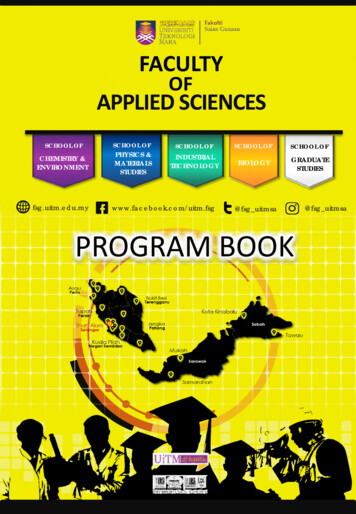
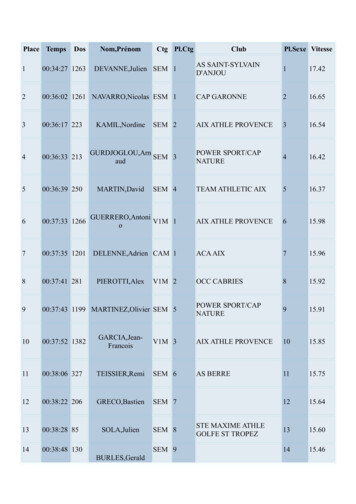
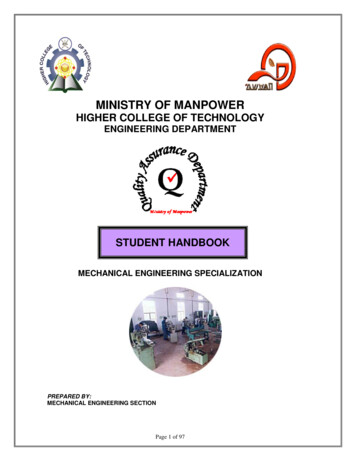
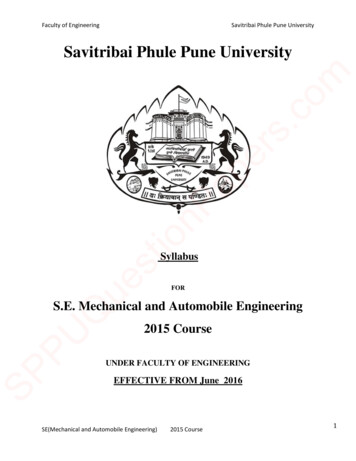

![[SEM] Structural Equation Modeling - Stata](/img/31/sem.jpg)
